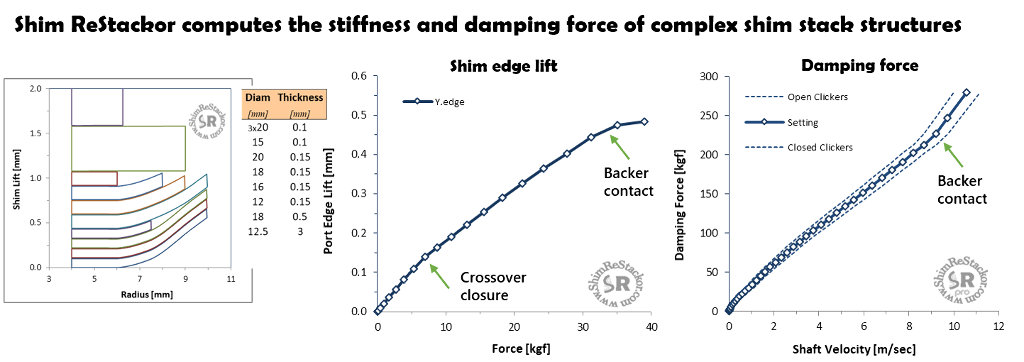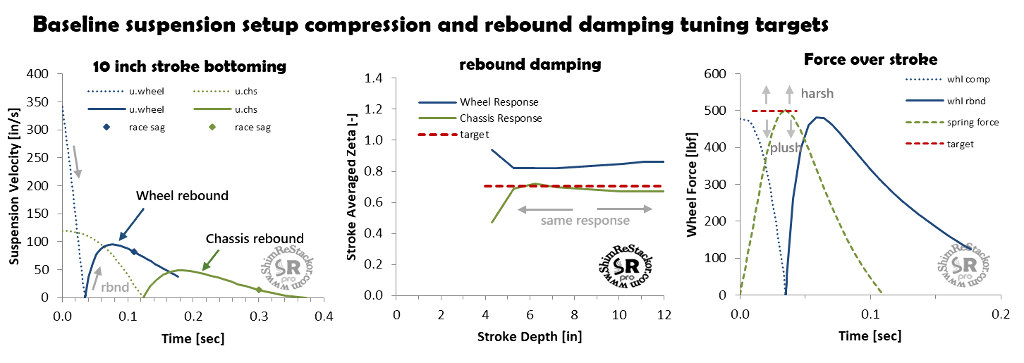Shock absorber performance is a multi-physics problem involving fluid dynamics, shim stack structural stiffness and dynamic response of the suspension system. Those are hard problems and must be solved simultaneously as a coupled system to obtain a physics based description of shock absorber performance in the suspension system.
Shim ReStackor solves those problems using simple inputs and thorough physics based analysis to produce practical results describing suspension performance across the entire range of bump velocities and suspension stroke depths.

Shim stack stiffness
Fluid dynamics
Suspension response
Shim stack stiffness
Shim factors and the thickness cubed rule provides a simple estimate of shim bending stiffness. However, the bend radius of a shim in a shim stack is different than the free bending radius of a single shim due to the shim stack tapper, clamp shim diameter and shim thickness changes through the stack. Crossover gaps further complicate the shim bending profile making the stiffness of a shim stack much different than a simple sum of individual shim stiffness.
Shim ReStackor uses finite element analysis (FEA) to evaluate the stiffness of shim stack structures. FEA breaks down each shim and the stack structure into smaller radial elements. Deflection of the element is dictated by forces transferred through the shim into the stack clamp, confined by the shims above and driven by deflection of the shims below.
Resolving deflection of a shim stack structure requires the forces transferred through each FEA analysis element to be in balance with forces transferred into and out of all surrounding elements.
Solution of FEA problems requires evaluation of thousands of simultaneous equations in an extremely computationally intensive operation. Fortunately, GHz speeds of modern computers makes those calculations possible in a matter of seconds giving Shim ReStackor the capability to thoroughly analyze complex shim stack structures using nothing more than a simple listing of shim diameter and thickness to describe the shim stack configuration (more).
Simple inputs - Thorough analysis - Pratcial results.

Fluid dynamics
Accurate analysis of shim stack stiffness is not enough to define shock absorber damping performance. Damping performance is dictated by the fluid flow resistance and pressure drop across the shock absorber valve. The pressure drop, in turn, defines the fluid forces acting on the shim stack face, the shim stack deflection and flow resistance, which defines the pressure drop itself. The tightly coupled system creates a highly interactive problem requiring the fluid dynamic pressure drop and shim stack deflection to be solved simultaneously as a coupled system.
Clicker bleed circuits, valve port leak jets, and flow restrictions at the valve port throat and port entrance create additional tunable features controlling damping performance of the shock absorber. Shim ReStackor fluid dynamic calculations model all of those features using simple geometric measurements of the valve configuration you can easily obtain in your garage and modify to optimize the damping performance of shock absorbers (more).
Suspension response
Suspension response calculations define the damping targets needed to optimize suspension response based on the combined spring rate, bike weight and rider weight. Tuning shocks to hit those damping targets simply requires hacking around on the shim stack, adding or removing shims, to hit the damping targets for compression and rebound (more).
Response calculations also define the jump height that bottoms the chassis and bump impact velocities that bottom the wheels. Knowing the shock shaft velocities where those events occur allows the shock absorber damping force curve to be bent around to control jump landings and then roll-off at high speed to improve wheel compliance on high speed impacts like braking bumps (more).



